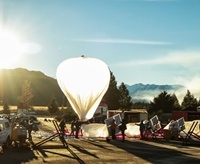Project Loon: Google to run another test flight of internet-beaming balloons
18 Nov 2014
Google plans to run another test flight of internet-beaming balloons under its Project Loon, with 20 new helium gas bags in partnership with Telstra.
 According to the Australian Associated Press, a second trial of the Moonshot project would take place over western Queensland in December.
According to the Australian Associated Press, a second trial of the Moonshot project would take place over western Queensland in December.
Project Loon is aimed at taking the internet to remote regions of the world at a low cost and with two distinct benefits for the advertising giant - making it look good and expanding its customer base.
To accomplish this easy-to-reach, cheap internet, Google plans to have helium balloons equipped with antennas capable of beaming 4G-type signals to phones and homes circling the globe on stratospheric winds.
The company had already run one test flight over Christchurch in New Zealand last year, which it said had favourable stratospheric conditions for initial tests.
Project Loon, one of Google's so-called Moonshot projects run from its secretive GoogleX lab, which was also responsible for Google Glass. Currently the balloons float at heights around twice the altitude of passenger jets.
The balloons themselves can circle the globe on stratospheric winds.
Each of the balloons carries antennas that can beam 4G-like internet signals to homes and phones on the ground 20km below the balloon, The Guardian reported.
Google will be teaming with Telstra to provide the base stations needed to provide the internet access. The company had already done test flight and service trial for Project Loon.
The first test flight for the helium balloons was conducted in Christchurch New Zealand, in June last year (See: Google reveals plan to beam internet from balloons in stratosphere).
Google is looking to eventually have a ring of balloons circling the earth to bring internet to consumers on the ground.
The company said its project could bring internet to two-thirds of the people who currently had no internet access. The Project Loon balloons are expected to appeal to developing nations as they eliminate costly fibre optic cables on the ground. Each of the balloons can stay afloat for 100 days.






















